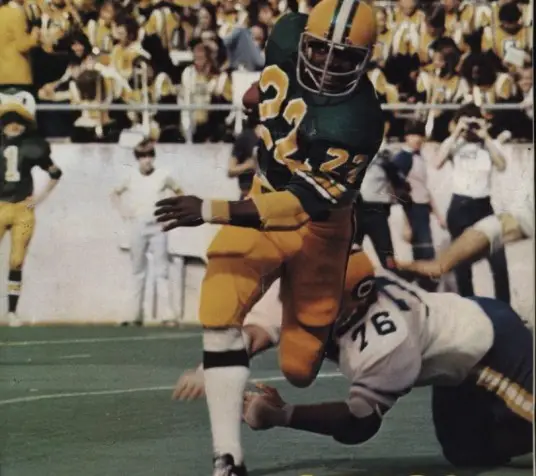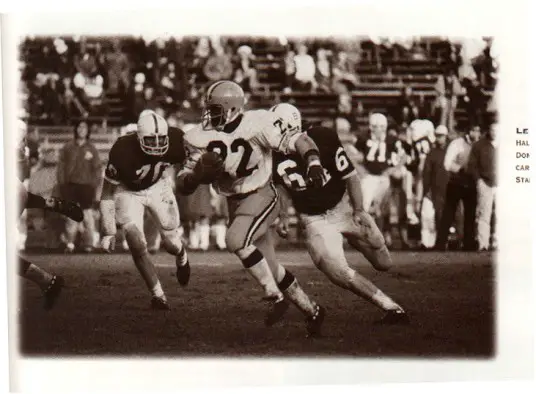 This is a two-part series by John Schroeder based on stories from his interviews with the great Don Reynolds, two-sport star in football and baseball, who played for the Ducks from 1971-1975.
This is a two-part series by John Schroeder based on stories from his interviews with the great Don Reynolds, two-sport star in football and baseball, who played for the Ducks from 1971-1975.
Don Reynolds came to Eugene in the fall of 1971 intent on solely playing baseball. Football was initially an afterthought to the 5’8″, 178-lb Reynolds, with many coaches believing that he was not big enough to play major college football. Duck coach Jerry Frei realized he was fortunate enough to have a player of Reynolds’ talent, and persuaded him to reconsider his single sport pursuit and join the freshman football team. (The NCAA would not allow freshmen to play on varsity teams until the following fall). Reynolds showed up for freshman football and dominated on both sides of the ball.
However, to Reynolds’ disappointment, the next fall he found himself second on the running back depth chart. Frustrated, he intended to finish the 1972 season before concentrating solely on baseball. Instead, his collegiate football career was guaranteed to last following his 1972 season, when Reynolds averaged 8.1 yards per carry, including a dazzling 85-yard run vs. Stanford; a run that was the second longest in school history (and still ranks fifth all-time).
Before the season, new coach Dick Enright made the proclamation that “this team was special” and many of those players would live up to that praise. Much has been made of new coach Dick Enright installing the option offense with the heavy-footed Fouts at quarterback [see footnote 1]. But contrary to popular opinion, and according to Reynolds, “Fouts ran the option pretty well and the Ducks used it often during that 1972 season”. In fact, as Reynolds says his 85 yard run against Stanford came on a deft option pitch from Fouts!
One of the only highlights of the ’72 football season came on November 18th, during that year’s Civil War in Corvallis. In Fouts’ last game at Oregon, the 4-7 Ducks walloped the Beavers 30-3. Reynolds ensured that the contest was over from the beginning, scampering for a 60-yard touchdown on the game’s first play from scrimmage. In the waning moments the insouciant Fouts fired up a celebratory cigar on the sideline while Norval Turner completed the game.
Finally witnessing an Oregon Civil War victory after eight straight defeats, the ebullient Duck fans rushed the field and tore down the south goalposts as the players were leaving the field. The apoplectic Beaver fans tried to defend the north goalposts from a similar fate, thereby guaranteeing the ensuing melee.
Despite the individual player successes, the early 1970’s were difficult times for the football program. Oregon admirably did not dodge the tough opponents, as they flew east and played the powerhouses of the era including at Oklahoma in ’72 and at Nebraska in ’74. Reynolds remembers well the game at Nebraska. During pre-game introductions, “they (the Nebraska players) ran out of the locker room for what seemed like five minutes.
They were four deep at every position and their sideline was a sea of red.” Oregon had no business being on the same field with teams like Oklahoma and Nebraska, with a big paycheck for the Oregon athletic department largely being the motivation. Nevertheless, armed with what he termed the “athlete’s mindset” and a fierce competitiveness leaving Reynolds feeling, “I’m as good as them; you always think that you have an opportunity.” “But by the third quarter”, he laughs while recalling, “you are thinking, they’re pretty good and we are done!”
In 1973, Reynolds became the second Duck to surpass 1,000 yards in a season capped by his 290 all-purpose yards against Utah. In early November, Reynolds hurt his ankle vs. Washington State. Unfortunately, the nature of his injury made the press, and it was well known by the time the Ducks met the hated Beavers at Autzen Stadium. Shortly after reaching 1,000 yards for the season, Reynolds was tackled and the ankle purposely targeted and twisted with malicious intent by Beaver tackler Jim Mott. Reynolds tried to roll with the torque being applied to his ankle but to no avail.
Compounding this dirty play, Reynolds heard the Oregon State player saying “I got him”, referring to the attempted inflicting of further injury. Reynolds calls this apparent bounty placed on him the most “chickens***” thing a player can do to another player. This incident had its roots partially in Reynolds choosing the Ducks over the Beavers and proved that there was and is no love lost between Oregon and Oregon State. Reynolds emphasizes that “competition should be pure” and about, “who is the better man. It is a game, after all.”
The 1974 season was his swan song, with Reynolds saving his best statistical game for his senior season against Northwestern. He ran all day on the Wildcats, finishing with a career high of 196 rushing yards on 23 carries, good for 8.5 yards per carry. He finished the 1974 season with 784 yards, on 4.8 yards per carry. He led the Ducks in rushing in all three of his seasons.
The 1975 NFL Draft came and went for Reynolds, who was not selected but says his phone started ringing with NFL general managers ten minutes after the draft ended [see footnote 2, below]. NFL teams were scared off by his dual sport status and unsure if he would commit to playing football instead of baseball. This was also the era of the fledgling World Football League and the Southern California Sun came calling along trying to persuade Reynolds to play with in the upstart league.
The WFL already had USC running back and fellow two-sport star Anthony Davis in the fold with the Sun. Reynolds remembers Davis recruiting him hard and playfully taunting him by flashing his Trojan National Championship rings. Reynolds does not doubt that he could have played professional football and in the NFL but he made a strategic and a health decision to concentrate fully on baseball.
Coming Tuesday: How Reynolds arrived in Eugene, and how his other sport lengthened his career.
[1] The option offense was in vogue during the College Football heyday of the 1970’s with Nebraska and Oklahoma perfecting it.
[2] The first running back taken in the 1975 NFL Draft was Walter Payton.
These are articles where the writer left and for some reason did not want his/her name on it any longer or went sideways of our rules–so we assigned it to “staff.” We are grateful to all the writers who contributed to the site through these articles.

